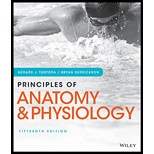
Principles of Anatomy and Physiology
15th Edition
ISBN: 9781119329398
Author: Gerard J Tortora, Bryan Derrickson
Publisher: John Wiley & Sons Inc
expand_more
expand_more
format_list_bulleted
Question
Chapter 24, Problem 22CP
Summary Introduction
To review:
The role of pepsin enzyme and the reason for its secretion in an inactive form.
Introduction:
The gastric glands in the stomach have many different cells like mucus-neck cells, chief cells, and the parietal cells, which secrete various enzymes involved in digestion of food. The chief cells produce pepsinogen, which is the inactive form of the enzyme pepsin.
Expert Solution & Answer
Want to see the full answer?
Check out a sample textbook solution
Students have asked these similar questions
Generate one question that requires a Punnet Squre to solve the question. Then show how you calculate the possibilities of genotype and phenotype
Briefly state the physical meaning of the electrocapillary equation (Lippman equation).
Explain in a small summary how:
What genetic information can be obtained from a Punnet square? What genetic information cannot be determined from a Punnet square?
Why might a Punnet Square be beneficial to understanding genetics/inheritance?
Chapter 24 Solutions
Principles of Anatomy and Physiology
Ch. 24 - Which components of the digestive system are GI...Ch. 24 - 2. Which organs of the digestive system come in...Ch. 24 - Which kinds of food molecules undergo chemical...Ch. 24 - Prob. 4CPCh. 24 - 5. Name the four layers of the gastrointestinal...Ch. 24 - Prob. 6CPCh. 24 - Prob. 7CPCh. 24 - Prob. 8CPCh. 24 - Prob. 9CPCh. 24 - Prob. 10CP
Ch. 24 - How are the major salivary glands distinguished on...Ch. 24 - Prob. 12CPCh. 24 - What functions do incisors, cuspids, premolars,...Ch. 24 - To which two organ systems does the pharynx...Ch. 24 - Prob. 15CPCh. 24 - Prob. 16CPCh. 24 - Prob. 17CPCh. 24 - Prob. 18CPCh. 24 - Prob. 19CPCh. 24 - 20. Compare the epithelium of the esophagus with...Ch. 24 - Prob. 21CPCh. 24 - Prob. 22CPCh. 24 - What are the functions of gastric lipase and...Ch. 24 - Prob. 24CPCh. 24 - Prob. 25CPCh. 24 - Prob. 26CPCh. 24 - Prob. 27CPCh. 24 - Prob. 28CPCh. 24 - Prob. 29CPCh. 24 - Prob. 30CPCh. 24 - Describe the major functions of the liver and...Ch. 24 - 32. List the regions of the small intestine and...Ch. 24 - Prob. 33CPCh. 24 - Describe the types of movement that occur in the...Ch. 24 - Prob. 35CPCh. 24 - What is the difference between digestion and...Ch. 24 - By what routes do absorbed nutrients reach the...Ch. 24 - 38. Describe the absorption of electrolytes,...Ch. 24 - What are the major regions of the large intestine?Ch. 24 - Prob. 40CPCh. 24 - 41. Describe the mechanical movements that occur...Ch. 24 - What is defecation, and how does it occur?Ch. 24 - Prob. 43CPCh. 24 - What is the purpose of the cephalic phase of...Ch. 24 - Prob. 45CPCh. 24 - 46. Outline the steps of the enterogastric...Ch. 24 - Prob. 47CPCh. 24 - Prob. 48CPCh. 24 - 49. What are the general effects of aging on the...Ch. 24 - Prob. 1CTQCh. 24 - Trey has cystic fibrosis, a genetic disorder that...Ch. 24 - Antonio had dinner at his favorite Italian...
Knowledge Booster
Learn more about
Need a deep-dive on the concept behind this application? Look no further. Learn more about this topic, biology and related others by exploring similar questions and additional content below.Similar questions
- In a small summary write down:arrow_forwardNot part of a graded assignment, from a past midtermarrow_forwardNoggin mutation: The mouse, one of the phenotypic consequences of Noggin mutationis mispatterning of the spinal cord, in the posterior region of the mouse embryo, suchthat in the hindlimb region the more ventral fates are lost, and the dorsal Pax3 domain isexpanded. (this experiment is not in the lectures).a. Hypothesis for why: What would be your hypothesis for why the ventral fatesare lost and dorsal fates expanded? Include in your answer the words notochord,BMP, SHH and either (or both of) surface ectoderm or lateral plate mesodermarrow_forward
arrow_back_ios
SEE MORE QUESTIONS
arrow_forward_ios
Recommended textbooks for you
 Human Physiology: From Cells to Systems (MindTap ...BiologyISBN:9781285866932Author:Lauralee SherwoodPublisher:Cengage Learning
Human Physiology: From Cells to Systems (MindTap ...BiologyISBN:9781285866932Author:Lauralee SherwoodPublisher:Cengage Learning Human Biology (MindTap Course List)BiologyISBN:9781305112100Author:Cecie Starr, Beverly McMillanPublisher:Cengage Learning
Human Biology (MindTap Course List)BiologyISBN:9781305112100Author:Cecie Starr, Beverly McMillanPublisher:Cengage Learning Concepts of BiologyBiologyISBN:9781938168116Author:Samantha Fowler, Rebecca Roush, James WisePublisher:OpenStax College
Concepts of BiologyBiologyISBN:9781938168116Author:Samantha Fowler, Rebecca Roush, James WisePublisher:OpenStax College Comprehensive Medical Assisting: Administrative a...NursingISBN:9781305964792Author:Wilburta Q. Lindh, Carol D. Tamparo, Barbara M. Dahl, Julie Morris, Cindy CorreaPublisher:Cengage LearningEssentials of Pharmacology for Health ProfessionsNursingISBN:9781305441620Author:WOODROWPublisher:Cengage
Comprehensive Medical Assisting: Administrative a...NursingISBN:9781305964792Author:Wilburta Q. Lindh, Carol D. Tamparo, Barbara M. Dahl, Julie Morris, Cindy CorreaPublisher:Cengage LearningEssentials of Pharmacology for Health ProfessionsNursingISBN:9781305441620Author:WOODROWPublisher:Cengage

Human Physiology: From Cells to Systems (MindTap ...
Biology
ISBN:9781285866932
Author:Lauralee Sherwood
Publisher:Cengage Learning

Human Biology (MindTap Course List)
Biology
ISBN:9781305112100
Author:Cecie Starr, Beverly McMillan
Publisher:Cengage Learning

Concepts of Biology
Biology
ISBN:9781938168116
Author:Samantha Fowler, Rebecca Roush, James Wise
Publisher:OpenStax College


Comprehensive Medical Assisting: Administrative a...
Nursing
ISBN:9781305964792
Author:Wilburta Q. Lindh, Carol D. Tamparo, Barbara M. Dahl, Julie Morris, Cindy Correa
Publisher:Cengage Learning

Essentials of Pharmacology for Health Professions
Nursing
ISBN:9781305441620
Author:WOODROW
Publisher:Cengage
Human digestive system - How it works! (Animation); Author: Thomas Schwenke;https://www.youtube.com/watch?v=X3TAROotFfM;License: Standard Youtube License